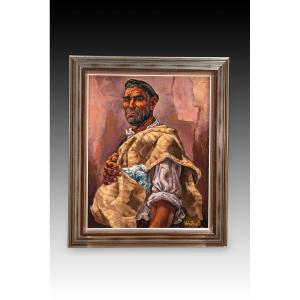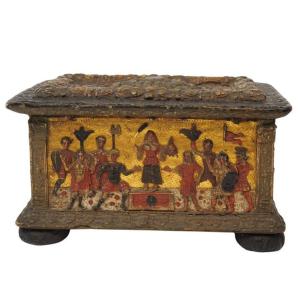With inscription.
Casket with a rectangular base and a semicircular lid slightly raised on four plant-shaped feet ending in a hoof (and placed on a ball), decorated on the outside with a careful composition based on plant forms and simplified volutes, with marked symmetry, the lid ending in a decorative element of clear shapes. At the front, it closes with a piece of the same material, connected to the casket by a small chain; at the back, it has hinges decorated with a balustrade and two balls that recall decorative elements widely used in the Spanish Renaissance in the Escorial region. The base bears an inscription: "S. Bartholomew El Real de Calegoen. Year 1617". It is not common to preserve a piece with such a detailed inscription regarding its date of manufacture and owner, although it is more common to preserve this type of work in liturgical environments (as it is part of a treasure) than in civil environments (where they have been replaced by boxes more in line with later tastes). The parish church of San Bartolomé el Real de Calegoen (Elgoibar) was built in 1617: researchers have found a 17th-century document in the church register from 1693 to 1764, and it is assumed that the church was already under construction in 1623 and was in operation in 1629, finally being inaugurated in 1716. This building, which is the current one, is the work of the architects Longa, Larraza and Ibero, and stands out for its Escurial influence, as well as its Baroque style. The chest also features a Renaissance reminiscence and some touches found in works related to the Royal Monastery of San Lorenzo de El Escorial in Madrid and the style that emerged from its construction. However, the top and legs of the piece are closer to the movement and tastes of 17th-century Spanish Baroque. As for the shape, it responds to a long tradition of which some medieval examples have also been preserved.
Weight: 540 grams. - Dimensions: 19x10x11 cm





























 Le Magazine de PROANTIC
Le Magazine de PROANTIC TRÉSORS Magazine
TRÉSORS Magazine Rivista Artiquariato
Rivista Artiquariato
